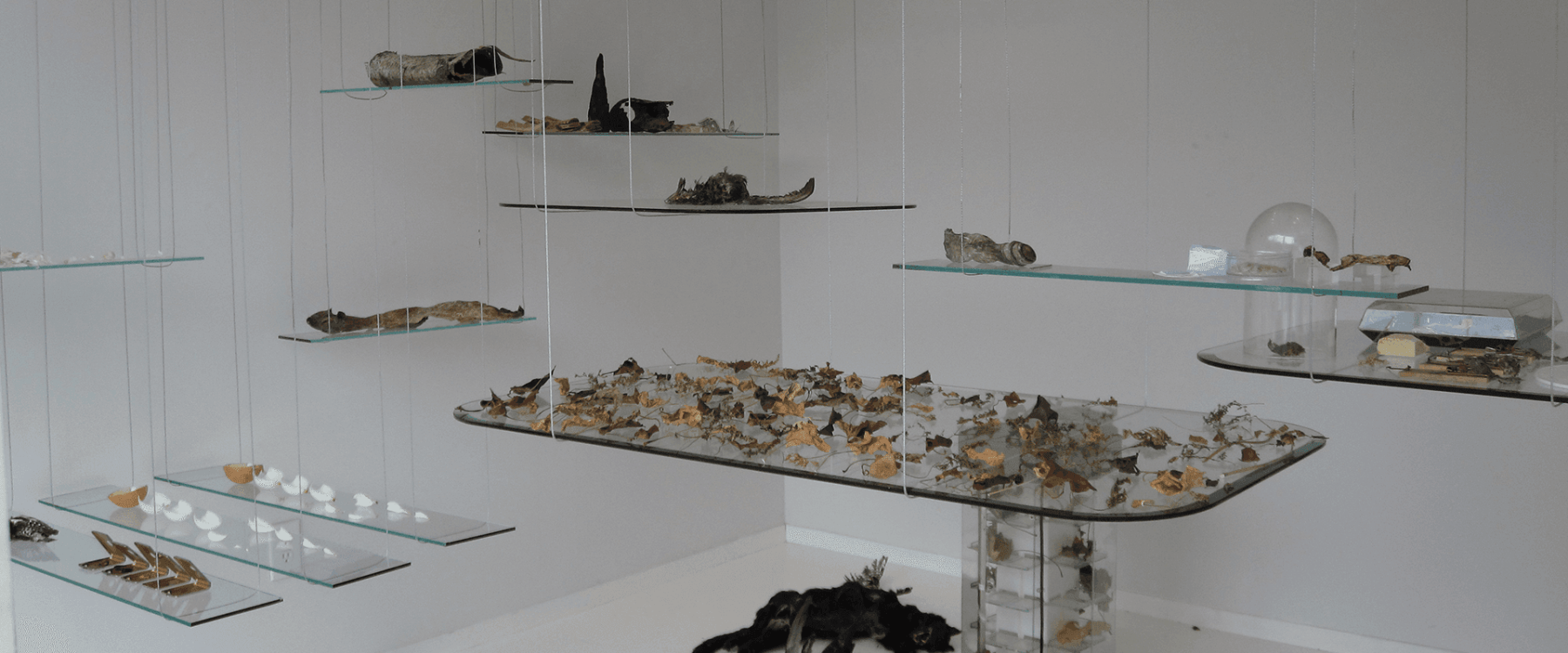Nader Hassan
Fall 2011
A NOTE TO THE PUBLIC
Nader Hasan is an autodidact (self-taught) in the arts of taxidermy. He began to teach himself these ancient skills through print and internet resources, later seeking out the knowledge of other taxidermists and textile artists, particularly with regard to working with hide. Refusing the widespread use of formaldehyde, Hasan’s work is part of a sustainable practice using the most environmentally friendly materials as possible. He has studied and practiced some ancient and prehistoric tanning methods, such as brain tanning and bark tanning. Remains of leather from these sorts of practices have been found on every continent on the planet, dating back 20,000-40,000 years. Hasan understands his work with found, dead animals as having a small part in this very ancient relationship between the living and the dead, a relationship that is often denied or disguised in contemporary society, yet concrete, material and ultimately irreducible. We all engage in it; Hasan, through his art, challenges us to engage in it consciously, and without the usual filters that wrap and package death today.
The works in this exhibition are the result of a deeply ethical consideration of the animals themselves. All animals in the exhibition were found dead and were salvaged from the streets of Montreal. The only exceptions are the mice, which were deliberately trapped and killed in domestic and commercial spaces as part of routine anti-vermin practices, entirely separate from the practices of the artist. Two finches, which may be seen in the hallowed piece of bark were given to Hasan by a friend, who had rented them for an event. They accidentally died in that person’s possession. Whether found on the streets, salvaged from other people’s vermin traps, or acquired through the small tragedy of an event gone wrong, these animals are all treated with the same respect in the artist’s hands, the pathos of the abrupt end to their lives made stunningly apparent in this series of works. Hasan’s art encourages the viewer to consider death through the lives and deaths of animals in our cities, our liminal and, too often, forgotten fellow-dwellers.
Although tanning and taxidermy practices are universal and ancient, Hasan has been very reserved in terms of his artistic interventions with, or modifications to the bodies. Hasan explains, “I almost always position them in the gallery in relatively the same position I have found them dead.” He has consciously avoided any form of presentation of the animals that could be perceived to be ornamental or decorative. Likewise, he eschews any presentation of the animals that might encourage a metaphoric reading of their small bodies. Above all, his intention is to avoid any trivialization of their lives, or violation of their remains. “I try to always hold myself to the highest of ethical standards; these are part of the very heart of my concerns and interests as an artist,” he explains. “I have never sold any animals I have ever worked on. I have never sold any of my art, for which I have received many offers. This has also been an obstacle to my relationship with the art world, because it is a market-driven community. I have only shared my knowledge of taxidermy with a few people, and have said no to over one hundred requests to be taught how to preserve animals, because I did not feel comfortable being involved with their intentions.”
This firm commitment to ethical practices points to another aspect of Hasan’s oeuvre, which is a subtle critique of the ways in which art has been, through the ages, dependent upon a very invisible, animal “other.” From parchment made of calfskin to cat gut strings in violins, red sable watercolour brushes and boar bristle oil painting brushes, the animal world has served artists for millennia. The death of these animals has been an integral part of how art has come into being. Hasan’s series of works presented at Whippersnapper Gallery refuses the well-rehearsed, binary logic that sees animal death as somehow necessary to cultural life, putting the animal’s death, and thus its existence, quite literally on the table before us.
Cynthia Hammond PHD
Concordia University






